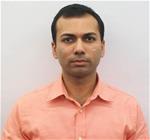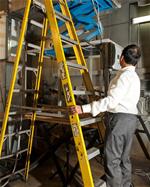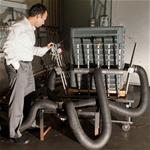Semant Jain
The honor of membership into Sigma Xi spans disciplines and courses of research study.
Each month in the Sigma Xi Today section of American Scientist magazine, and also on our website, we will be highlighting a different "Fellow Companion"—asking them about their work and what the honor of induction into Sigma Xi has meant for their career.
Today, we are excited to introduce Semant Jain, Ph.D., a Principal Engineer for Goodman Manufacturing in Houston, Texas. A native of India and a graduate of the extremely competitive Indian Institute of Technology, Jain completed his Ph.D. in engineering at the University of Michigan, with a focus on fuel cell research. Throughout his career he has re-engineered the engines of M1A1 Abraham tanks for the US Army to increase efficiency and decrease sound, modeled the DNA and rheology of polymers to answer decades old questions of their structure, AND he’s also currently a fashion photographer with work published in Vogue Italia! No stranger to the rigors and excitement of interdisciplinary research and working in teams, he now is a Principal Engineer for one of the largest manufacturers of residential air conditioners in the Unites States, developing new technologies daily to make the homes of millions of Americans more energy efficient.
Ph.D., a Principal Engineer for Goodman Manufacturing in Houston, Texas. A native of India and a graduate of the extremely competitive Indian Institute of Technology, Jain completed his Ph.D. in engineering at the University of Michigan, with a focus on fuel cell research. Throughout his career he has re-engineered the engines of M1A1 Abraham tanks for the US Army to increase efficiency and decrease sound, modeled the DNA and rheology of polymers to answer decades old questions of their structure, AND he’s also currently a fashion photographer with work published in Vogue Italia! No stranger to the rigors and excitement of interdisciplinary research and working in teams, he now is a Principal Engineer for one of the largest manufacturers of residential air conditioners in the Unites States, developing new technologies daily to make the homes of millions of Americans more energy efficient.
Tell us about your educational background including your doctoral research, if applicable.
I did my Bachelor's and Master's in Chemical Engineering at the Indian Institute of Technology (IIT)-Delhi in India. At that time, IITs had a 1% acceptance rate making acceptance between 8-10 times harder than Harvard or M.I.T. As I was interested in doing computational research, in addition to a 24 credit/semester course load, I was the only one in my class to graduate with a minor area in Computer Science. These additional courses were very helpful as I was able to build computer models and conduct simulations to do numerical research on porous media and membrane design. Both of these projects ended up getting published in Computers and Chemical Engineering(Ranked # 8 in Chemical Engineering Misc.) and Journal of Membrane Science (ranked # 1 in separation technology) to aid in enhanced oil recovery and efficient designs of membranes.
Thereafter, I completed my Ph.D. in Chemical Engineering at the University of Michigan, as the College of Engineering was ranked #5 globally in research. I started off by doing research on fuel cells to minimize idling of engines on M1A1 Abraham tanks used by the U.S. Army and long haul trucks. The intent was to reduce noise, improve fuel economy, and reduce heat signature for safety. This research paper was published in the Journal of Power Sources (#1 in energy) and the U.S. Army gave $ 5 million for further research which ended up establishing the Energy Institute in Ann Arbor, MI. For my Ph.D., I did research on modeling of DNA and rheology of polymers which solved a 50-year mystery in polymer rheology and helped identify an optimal computational model balancing speed with accuracy across time spectra (10-15 s to 10-3 s). Overall, this research has applications in drug discovery, drag reduction, and membrane design. These papers were published in Journal of Chemical Physics (# 1 in Atomic/Molecular Physics and Optics), Rheologica Acta (# 5 in Computational Mechanics),Macromolecules (# 2 in Materials Chemistry), and Chemical Engineering Science (#3 in Chemical Engineering Misc.)
Do you have a particular teacher or professor who inspired your love of science? Why?
For the last two years of high school, a few of my class mates and I were preparing for the grueling 9-hour entrance exam of IIT which tested Physics, Chemistry, and Mathematics. In high school, I had instructors who were very supportive of this effort. They helped us identify experiments that we could use for the school's final research project that would also be useful for the entrance exams. For Physics, I studied Leidenfrost effect which got me really interested into understanding fluid mechanics and I ended up doing a lot of computational research in fluid mechanics.
What is the focus of your current research?
 As I work in the industry, I’m always conducting research with the intent of commercialization or providing a business solution. I’ve done research on improving the heat transfer effectiveness on plate-fin heat exchangers through fine density optimization, air flow analysis, and circuitry studies. This analysis was used to design lighter, more robust, and more compact split residential air conditioners while meeting capacity and energy efficiency targets. 300,000 units using this technology were manufactured this season, saving the company $3 million.
As I work in the industry, I’m always conducting research with the intent of commercialization or providing a business solution. I’ve done research on improving the heat transfer effectiveness on plate-fin heat exchangers through fine density optimization, air flow analysis, and circuitry studies. This analysis was used to design lighter, more robust, and more compact split residential air conditioners while meeting capacity and energy efficiency targets. 300,000 units using this technology were manufactured this season, saving the company $3 million.
Currently, I’m developing an Object Oriented computational platform to accelerate research through automation of the design process. The components I’ve developed have reduced engineering time by 95% and the overall project is expected to improve productivity of the design engineers five times over.
Tell us about something we might see in our daily lives that directly correlates to your work.
Goodman is second largest manufacturer of residential air conditioning units in United States. If you own a 13 SEER 1.5 T or 2.0 T air conditioner which was manufactured in 2011 or 2012, there's a very high chance it's a Goodman unit which I helped design.
Give us an example of how multi-disciplinary research directly contributed to your work.
Residential air conditioners are placed in pretty harsh conditions—from the salty ocean breezes on the gulf coast to the freezing plains in the mid-west—with kids, pets, and strangers operating in close proximity. While I was focused on doing research for enhancing system performance, other team members examined the impact of such design changes on manufacturing, operational ease, service, and safety. A lot of quality testing and statistical analysis was also conducted to predict the system performance over several seasons as Goodman products come with a 10-year warranty.
harsh conditions—from the salty ocean breezes on the gulf coast to the freezing plains in the mid-west—with kids, pets, and strangers operating in close proximity. While I was focused on doing research for enhancing system performance, other team members examined the impact of such design changes on manufacturing, operational ease, service, and safety. A lot of quality testing and statistical analysis was also conducted to predict the system performance over several seasons as Goodman products come with a 10-year warranty.
What are your thoughts on the future of STEM education?
In "Did You Know" Karl Fisch said: "We are currently preparing students for jobs that don't yet exist, using technologies that haven't been invented, in order to solve problems we don't even know are problems yet." I totally agree with this statement and believe we must empower future generations with analytical skills that empower them to think beyond what's possible. STEM should be the core of these efforts. However, more than getting the right answer, the emphasis should be on the learning along the way and the journey. We must infuse the love of STEM, set the brains on fire, and let imagination take over.
Describe the patent/publishing experience—were there any bumps along the way for you?
In general, reviewers have invariably pointed out the article strengths and their detailed critique has been very helpful. Sometimes I wish they were not anonymous as I would have liked to establish a professional connection with them.
However, when I was developing a model for single stranded DNA, I ran computer simulation for months, and yet my predictions differed from the experimental results published in Physical Review Letters by 20%. My Ph.D. advisor had imagined this project would take a few months and I was a year into the analysis my results were disappointing. So, I constructed another theoretical model—and while my predictions were consistent with the previous analysis—they still differed from experimental analysis by 20%. My advisor was not happy with my performance. All the same, we decided to move on, and submitted the manuscript to Rheologica Acta. Within a week, we got an email from one of the reviewers—an author of the original experimental work—with a note that they had forgotten a factor of 10 in the experimental data. When I recalibrated the model with the corrected experimental data, the predictions were dead on. We had to force the authors to publish an erratum in Physical Review Letters. I learned to be very suspicious of experimental data from then onwards, and as much as I love developing computer models and running simulations, I now always think of developing the simplest theoretical solution.
What has the honor of induction into Sigma Xi meant to you?
Whilst doing my Ph.D., I was a member of Tau Beta Pi, which is the engineering honor society. As a four team officer, I was very active in the Michigan Gamma chapter—one of the largest. So, I've always liked to surround myself with equally driven colleagues. Sigma Xi seemed to be the perfect organization with a mixture of academics and professionals doing research.
Has Sigma Xi helped further your career? If so, how? If you haven’t started your career yet, how do you believe Sigma Xi will serve you in the future?
From the members I’ve met in Sigma Xi and my understanding of the society, the overall society seems to have an academic bent. I know there are a lot more members in industrial space as well. I would like to see Sigma Xi promoted more in the corporate research space as well, which I am certain would lend itself to more diverse networking opportunities and corporate-academic interactions.
What books are you currently reading for pleasure?
I’m lucky to get 5 hours of sleep per night, so, unfortunately I rarely get to read books for pleasure. However, after several months, I just finished The Corner Office. I’m quite fascinated by human psychology—in the work place and outside—and this was an excellent insight into the work place from the eyes of various CEOs and Senior Executives of top-notch companies.
I’m more into reading articles on New York Times website and Reader’s Digest. To study fashion photography, I subscribe to W magazine and Vogue.
When you're not working on your research, what do you do in your free time?
I have three principal hobbies which I rotate through over the years: photography, dancing, and motivational public speaking. When I was a Ph.D. student, I was on the University of Michigan’s Ballroom and Latin Dance Team which offered me an opportunity to compete all the way up to collegiate nationals. Once I started working, through Toastmasters, I competed in the International Speech Contest towards the World Champion of Public Speaking. Currently, I’m a fashion photographer specializing in editorial spreads. I’ve had my photographs published by Camilla, an Australian designer whose designs have been worn by Oprah Winfrey and Eva Longoria, amongst other celebrities, and recently I had a photograph accepted in Vogue Italia.
What’s your favorite movie?
There are quite a few: The Godfather, Star Wars, Chitty Chitty Bang Bang, and The Sound of Music.
What is your favorite motto?
When I was preparing for the World Championship of Public Speaking, I listened to the tape of the 2001 champion Darren LaCroix. There’s a line in his speech which summarizes the great yearning, sweat, blood, and tears that go into any great endeavor and yet, sometimes, we fail:
"If you are willing to fail, you can learn anything”
What advice would you give a young researcher just starting out in your field?
One of the quotes from the late Steve Jobs who has been an inspiration in my life answers this question: "You've got to find what you love. And that is as true for your work as it is for your lovers. Your work is going to fill a large part of your life, and the only way to be truly satisfied is to do what you believe is great work. And the only way to do great work is to love what you do. If you haven't found it yet, keep looking. Don't settle. As with all matters of the heart, you'll know when you find it. And, like any great relationship, it just gets better and better as the years roll on. So keep looking until you find it. Don't settle."
Sigma Xi just celebrated its 125th year. What advances do you see in your field of research over the next 125 years?
Did you see the unbelievably amazing video: "We are living in exponential times"?
This truly hits home how fast times are changing and the impact it's having on our professional and personal lives. I would have to be an awesome fortune teller to be able to answer the question that was asked for just the next 5 years, to speak nothing of 125 years! All the same, I'm confident that it'll be driven by scientists and engineers who're always seeking to identify creative solutions to not merely alleviate the problems of today through incremental solutions, but also through game changing ideas.